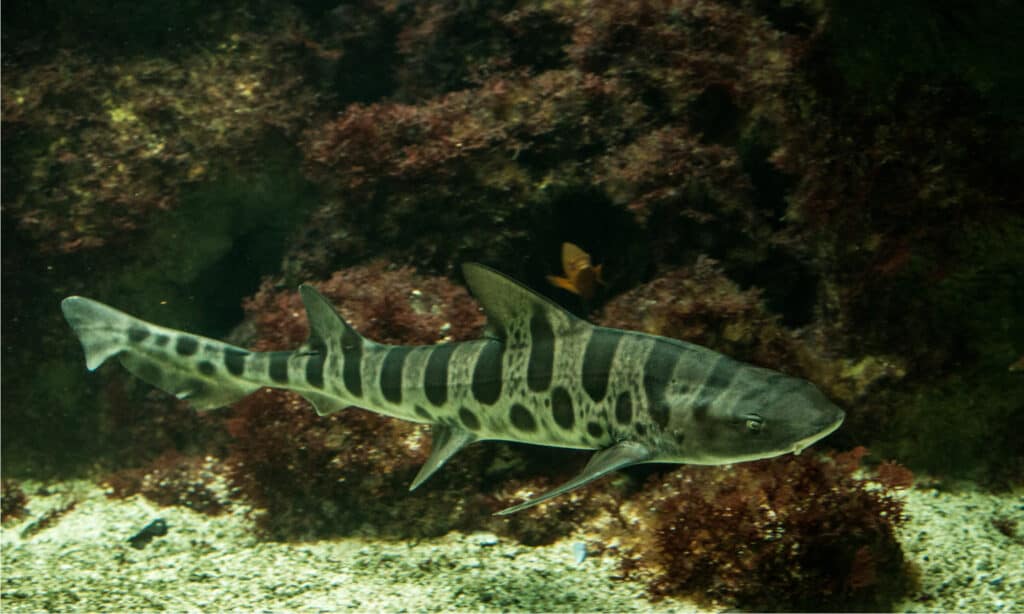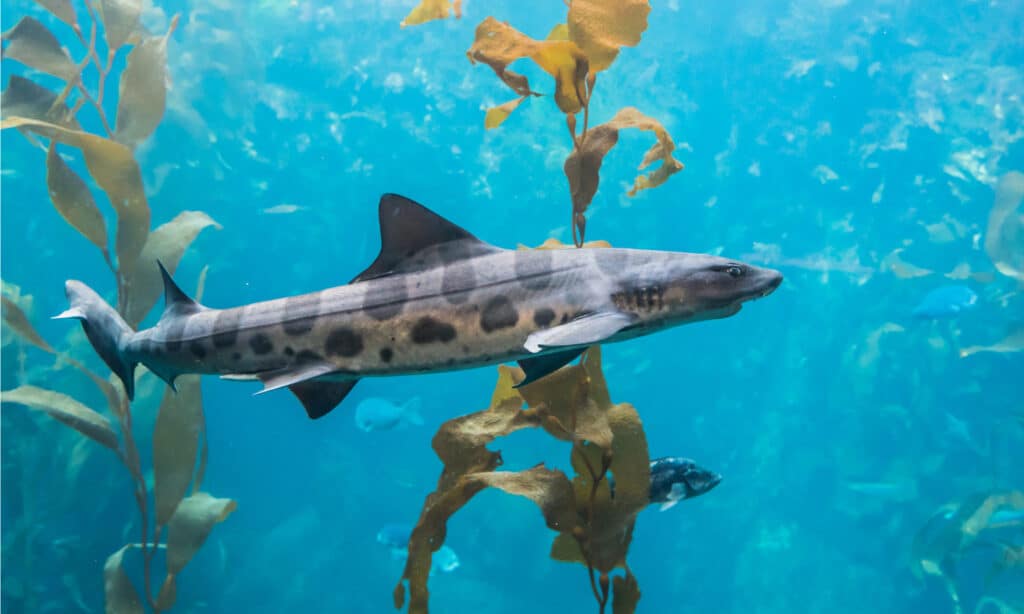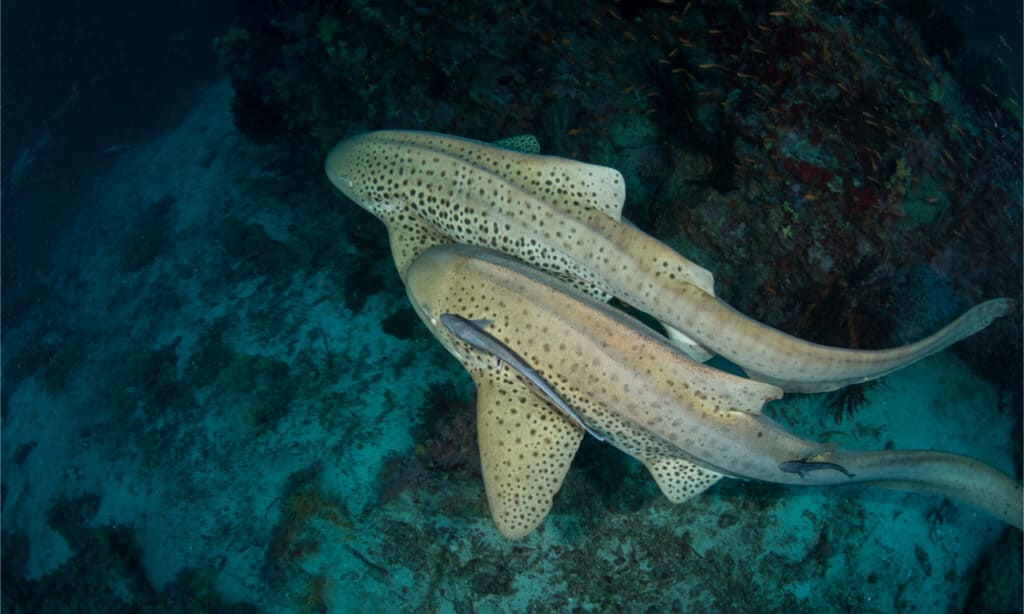Leopard Shark
Triakis semifasciata
Leopard Sharks have teeth with three points.
Advertisement
Leopard Shark Scientific Classification
- Kingdom
- Animalia
- Phylum
- Chordata
- Class
- Chondrichthyes
- Order
- Carcharhiniforme
- Family
- Triakidae
- Genus
- Triakis
- Scientific Name
- Triakis semifasciata
Read our Complete Guide to Classification of Animals.
Leopard Shark Conservation Status
Leopard Shark Facts
- Prey
- Crabs, Clams, Fish Eggs
- Name Of Young
- Pups
- Group Behavior
- Mainly solitary
- Fun Fact
- Leopard Sharks have teeth with three points.
- Biggest Threat
- Reduction of habitat
- Most Distinctive Feature
- Banded back
- Habitat
- Ocean
- Predators
- Larger sharks
- Diet
- Carnivore
- Lifestyle
- Nocturnal
- Favorite Food
- Crabs and Clams
- Number Of Species
- 1
Leopard Shark Physical Characteristics
- Color
- Brown
- Grey
- Black
- White
- Tan
- Skin Type
- Scales
- Weight
- 20-40 pounds
- Length
- 4-5 feet
- Age of Sexual Maturity
- 10 years
- Venomous
- No
- Aggression
- Low
View all of the Leopard Shark images!

Leopard Sharks are known for their striking patterns, which give them their name and fascinating appearance.
These sharks live on the West Coast of North America where they eat small ocean creatures such as clams, crabs, and shrimp. They are harmless to humans and popular in aquariums due to their interesting patterns.
5 Leopard Shark Facts

Leopard sharks can live up to 30 years!
©evantravels/Shutterstock.com
- Leopard Sharks have teeth with three points.
- One of the most easily identified features of a Leopard Shark is the banded pattern on its back.
- Leopard Sharks sink when they are not swimming.
- Leopard Sharks eat crabs, clams, shrimp, fish eggs, larger fish, other small sharks, and octopuses.
- These sharks contain high levels of mercury and should only be eaten sparingly.
Evolution and Origins
Leopard Sharks, or Triakis semifasciata, is a species of shark that belong to the family Triakidae. They are commonly found in the shallow waters of the Pacific Ocean along the coast of western North America.
Leopard Sharks have a long evolutionary history that dates back to the Cretaceous period, around 100 million years ago. Fossils of their ancestors have been found in Europe, Asia, and North America, indicating that they were once widely distributed across the globe.
Over time, their range has become more limited, and today they are primarily found along the western coast of North America.
Despite this, Leopard Sharks remain a vital part of the ocean ecosystem, serving as both predator and prey for other species, and their unique banded pattern continues to capture the attention and interest of marine enthusiasts and researchers alike.
Classification and Scientific Name

Leopard Sharks are known in scientific circles as
Triakis semifasciata.
©Jiri Hrebicek/Shutterstock.com
Leopard Sharks are known in scientific circles as Triakis semifasciata. They belong to the Triakis genus, which includes five species. Triakis means “three-pointed.” These sharks were named this due to their three-pointed teeth.
They are part of the Triakidae family. These sharks are also known as hound sharks. They all have two dorsal fins and one anal fin. They also have a translucent eyelid that keeps their eyes protected while maintaining vision, called a nictitating membrane.
Leopard Sharks are part of the Carcharhiniformes order of ground sharks. Ground sharks have the same fin placement and nictitating membrane as hound sharks. They belong to the Selachimorpha clade, classifying them as sharks. All sharks are part of the Chondrichthyes class. These include all fish with cartilage skeletons. They belong to the Chordata phylum and Animalia kingdom.
Appearance

Leopard Sharks are inhabitants of the Pacific Ocean and can be found off the coasts of Mexico and the western United States.
©David A Litman/Shutterstock.com
The most striking and recognizable feature is the Leopard Shark’s banded pattern on its back. These sharks have gray bodies and black or dark brown bands, with lighter-colored markings in the center. Dark circular spots dot their backs in between the bands. Their underbellies are white.
These sharks are around 20 pounds and between 4 and 5 feet long. They are medium-sized sharks but have shorter bodies that are compact. Females are larger than males, often by up to a foot in length. The largest Leopard Shark on record weighed just over 40 pounds.
They have two dorsal fins that are of similar size. Their anal fin is much smaller. These fins help them move through the water. Leopard Sharks swim near the ocean floor, where most of their food lives.
Their genus name, Triakis, means “three-pointed” and refers to their teeth. Leopard Sharks have between 41 and 55 teeth in their upper jaw and between 34 and 45 teeth in their lower jaw. These teeth have a smooth-edge pointed cusp in the center and an additional smaller cusp on each side. Because of this, scientists named the genus “three-pointed” or Triakis.
Distribution, Population, and Habitat

Leopard Sharks can be found in the Pacific Ocean along the western coasts of the United States and Mexico.
©SunflowerMomma/Shutterstock.com
Leopard Sharks live off the West Coast of the United States and Mexico in the Pacific Ocean. They have a relatively small habitat, which runs from Oregon down to the Gulf of California. They can be found there year-round and do not migrate very far.
These sharks like to explore inlets, making them easy to spot and study. Researchers can identify them easily by their markings. Many Leopard Sharks come to Matlahuayl State Marine Reserve in La Jolla, California, which is now protected waters. Scientists at the San Diego Zoo see them often in the warmer summer months. The sharks they study include many pregnant females.
Leopard Sharks like to swim near the ocean floor. They store oil in their livers to help them maintain their position in the water. Many fish have air sacs to maintain buoyancy. This means that they float when they are not swimming. Leopard Sharks, on the other hand, do not have air sacs. They tend to sink when they aren’t swimming. Their food is often closer to the ocean floor, however, which makes this arrangement work for them.
These sharks are not considered endangered. They have protected waters to live in and are not hunted regularly by humans. They are occasionally caught and eaten. However, they contain high levels of mercury due to their long lifespans. This makes them less than ideal for human food.
Where to find: Leopard Sharks and How to Catch Them

If you’re interested in fishing for Leopard Sharks, they tend to inhabit the same locations and are easily identifiable.
©John Back/Shutterstock.com
If you do want to fish for Leopard Sharks, they are easy to spot and often frequent the same areas. Squid, mussels, and sand crabs all make tasty bait for Leopard Sharks. However, check with local authorities to see if you are able to fish for Leopard Shark. In some locations, they are protected. Some waters are protected from all fishing.
Predators and Prey
Like all animals, Leopard Sharks are at risk when their natural habitat or reproduction habits are impacted. Leopard Sharks take a long time to reach maturity. Fishing for and catching juvenile Leopard Sharks can have an effect on the overall population if these sharks are not able to reproduce.
What eats Leopard Shark?
Other fish and sharks do not generally eat Leopard Sharks. Instead, their risk for survival comes from their dwindling habitat. They are also occasionally caught for their fins or as by-catch in large-scale fishing operations.
Larger sharks, such as the Sevengill Sharks may be tempted by a tasty juvenile Leopard Shark snack. Staff at places like the Monterey Bay Aquarium have to be careful to keep the young Leopard Sharks in smaller exhibits until they grow large enough to not be of interest to larger sharks anymore. They can then go into large exhibits, such as the Kelp Forest or Open Ocean tanks.
What do Leopard Sharks eat?
Leopard Sharks’ mouths open downward, bringing up food from the ocean floor. They suck up crabs, clams, shrimp, and fish eggs like a vacuum. As they grow, they move on to larger fish, other sharks, and even octopuses.
Reproduction and Lifespan
Leopard Sharks give birth similar to humans! No, they don’t go into the hospital with celebratory balloons, but they do give birth to live young. They are called pups as babies and are around 8 or 9 inches long. Mother Leopard Sharks do have eggs but they are kept internally. The eggs hatch inside the mother, who then gives birth to up to 30 pups at a time.
It takes around 10 years for a female Leopard Shark to reach breeding age. Because of this, they can experience dwindling population numbers. It takes a long time for a newly born pup to reach adulthood. Researchers take special interest in pregnant female Leopard Sharks and their habits to help with conservation efforts.
Fishing and Cooking
Leopard Sharks are not frequently fished for or caught intentionally. A few fishing companies, mostly commercial, do sell the fins of Leopard Sharks as a delicacy.
More often, Leopard Sharks are caught in larger nets when boats are fishing for other species. Some recreational fishers like to fish for Leopard Sharks. Just do your research and make sure that you are not fishing for Leopard Sharks (or any other species) in protected waters.
They contain high levels of mercury, a known toxic substance. You can eat Leopard Shark. But like other large fish, such as tuna, you should limit your consumption to avoid consuming too much mercury which can lead to health problems.
View all 98 animals that start with LLeopard Shark FAQs (Frequently Asked Questions)
Is Leopard Shark a good fish to eat?
While you can eat Leopard Shark, you should do so sparingly due to the high mercury content in the fish.
What does Leopard Shark taste like?
Leopard Shark is a firm, white fish that can be seasoned and panfried or grilled.
What kind of fish is a Leopard Shark?
Leopard Sharks are part of the Triakidae family, also known as houndsharks.
Is a Leopard Shark a freshwater or saltwater fish?
Leopard Sharks live in saltwater in the Pacific Ocean, off the West Coast of North America from Oregon to the Gulf of California, Mexico.
How big are Leopard Sharks?
Adult Leopard Sharks are usually between 5 and 6 feet long and around 20 pounds. Female Leopard Sharks are larger than males.
Thank you for reading! Have some feedback for us? Contact the AZ Animals editorial team.
Sources
- San Diego Zoo / Accessed June 17, 2022
- UCSD / Accessed June 17, 2022
- Monterey Bay Aquarium / Accessed June 17, 2022


















